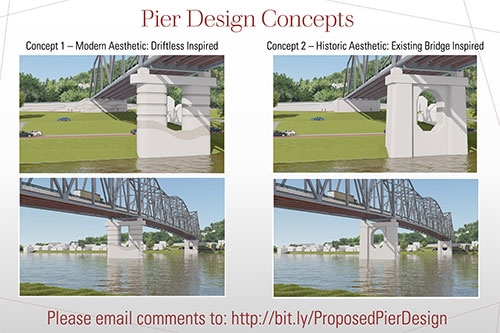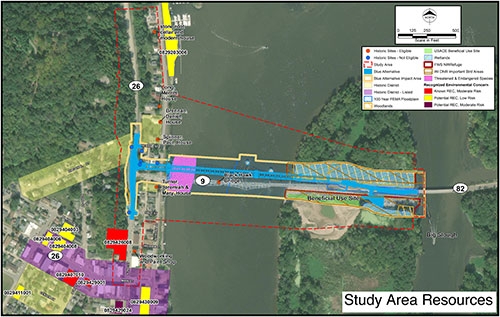You are here
Home ›June 15 meeting by Iowa DOT reveals location and design of Black Hawk Bridge replacement, explains environmental assessment

Proposed bridge design is very similar ... The image above shows the proposed design for the bridge being planned to replace the current Black Hawk Bridge, one of the topics of discussion at a June 15 public meeting held virtually. One will notice that the design is very similar to the current Black Hawk Bridge. Image courtesy of the Iowa Department of Transportation and can be viewed in greater detail at https://iowadot.gov/pim/documents/061521Iowa9AllamakeePD3.pdf.

Options for proposed bridge pier designs ... The images above show the proposed designs for the bridge piers to be used for the new bridge being planned to replace the current Black Hawk Bridge. The two designs include a “Driftless Inspired” design (at left) and an “Existing Bridge Inspired” design (at right). Image courtesy of the Iowa Department of Transportation and can be viewed in greater detail at https://iowadot.gov/pim/documents/061521Iowa9AllamakeePD6.pdf.

Proposed route for new bridge just slightly north of existing Black Hawk Bridge ... The map image pictured at left shows an aerial view of both the current Black Hawk Bridge (gray line with number “9” inside white circle indicating Highway 9 near center of submitted image) and the proposed new bridge (sky blue outline just above current bridge location). The map image also indicates historical sites and areas within the community of Lansing, as well as other areas and items of environmental and project logistic interest studied by the Iowa Department of Transportation in regard to the proposed replacement project for the Black Hawk Bridge, the topic of a June 15 meeting held virtually to gather further public input. Image courtesy of the Iowa Department of Transportation and can be viewed in greater detail at https://iowadot.gov/pim/documents/061521Iowa9AllamakeePD7.pdf.
Public input may still be provided through June 30
by Susan Cantine-Maxson
The Iowa Department of Transportation’s (DOT) public meeting held online Tuesday, June 15 dealt with the environmental impacts of building a new bridge to replace the current Black Hawk Bridge over the Mississippi River at Lansing. The purpose of the meeting was to inform the public about the preferred placement and design of the bridge, receive public input and explain the environmental assessment conducted in conjunction with the newly proposed bridge.
The 55 individuals attending the online meeting voiced several positive comments about the design of the new bridge since it is similar to the design of the historic Black Hawk Bridge which currently spans the river. The proposed new bridge will be built directly to the north of the current bridge (the Blue Alternative as it has been/continues to be labeled in Iowa DOT plans that have offered four color-labeled location options). The current bridge will be demolished since no viable entity has been approved to adopt the bridge after a process of nearly two years, according to Iowa DOT officials, to try and find an appropriate entity to feasibly adopt the bridge.
LOCAL IMPACT
The Blue Alternative placement of the new bridge has the least effect on all the factors combined considering historical, environmental and archaeological studies. Right now, the proposed plan will require the removal of two houses directly north of the bridge toward its west end in Lansing.
It is possible additional easements and right-of-ways may be needed, depending on the areas needed for the bridge approaches. Any property owners will typically be notified a minimum of 90 days but usually six months prior to any additional land acquisitions that may be needed. Additional meetings will be scheduled this fall to discuss right-of-way needs.
PROJECT DETAILS
This $80.8 million project will start with bids planned to be let during the fiscal year 2023-2024. The project will be completed in conjunction with the Wisconsin Department of Transportation, which will pay half the cost.
The build will take approximately two years. The current bridge will remain open most of that time, except for the last few months of the project when approach work will be completed during the late summer/fall of 2025. The time frame for bridge closure, when people will have to find alternate routes to cross the Mississippi River, may run from two to five months. It was explained that all these dates are tentative depending on the progress of the project.
The Iowa DOT held three public meetings in regard to the new bridge project prior to the June 15 meeting, beginning in 2017. During those meetings, the need for a new bridge was emphasized as well as several topics impacted by the bridge replacement, including historical and archaeological effects.
The current bridge, because of its age (90 years) and dimensions, causes problems for both highway and river traffic; the new bridge will improve the dimensions of the bridge, which will allow for better and safer traffic flow.
The current bridge is 21 feet wide; the new bridge will have two 12-foot travel lanes with eight-foot shoulders, making the width of the new bridge almost double the width of the old bridge. If a car needs to pull over, traffic should still be able to get by safely. The wider shoulders also should allow space for bicyclists or pedestrians to travel over the bridge, although no such designated routes have been established in the initial plans.
The height and weight limits of the current bridge do not meet the needs of modern-day commercial truck traffic, and the new bridge will be constructed with higher clearance. In addition to the added width, the bridge approaches on both the Iowa and Wisconsin side will be improved, which will allow for better turning for large trucks. Entrances to the Big Slough boat landing just beyond the east end of the current Black Hawk Bridge will be enhanced as well.
River navigation for barges will be easier because of the change in placement of the concrete piers under the bridge. Currently, they are 600 feet apart. The U.S. Coast Guard requires that the new piers be 750 feet apart. This additional width will make one of the more difficult turns in the Mississippi River easier for vessel navigation. The old piers will be removed, approximately one foot below their current ground level. The public may weigh in on the design style of the piers (see accompanying image on Page 1) by posting comments at the website listed below.
Public feedback has been encouraged during all the meetings with comments online also being an option. Individuals may go to www.iowadot.gov/pim and click on “Iowa 9 (Black Hawk) Bridge Meeting Online” to view a 15-minute video regarding the project, as well as the nearly hour-long video of the June 15 meeting (at least through June 30), read through any comments and post their own comments.
This video also summarizes the process that has preceded the decisions explained at the June 15 meeting. Comments about the design choice or other relevant topics should be completed by next Wednesday, June 30.
Several participants in the meeting had questions about the lighting of the bridge. It was explained that this is an additional cost which is currently being discussed with the City of Lansing. Lighting the bridge has become a tradition to celebrate a special occasion or to remember a loved one, and several people said they hoped this would continue. The Lansing Lions Club has offered this service for several years.
Additional questions regarding the bridge replacement project can be directed to Krista Billhorn, Iowa DOT District 2 Office Transportation Planner at 641-423-7584 or 800-477-4368 or by email at krista.billhorn@iowadot.us.

